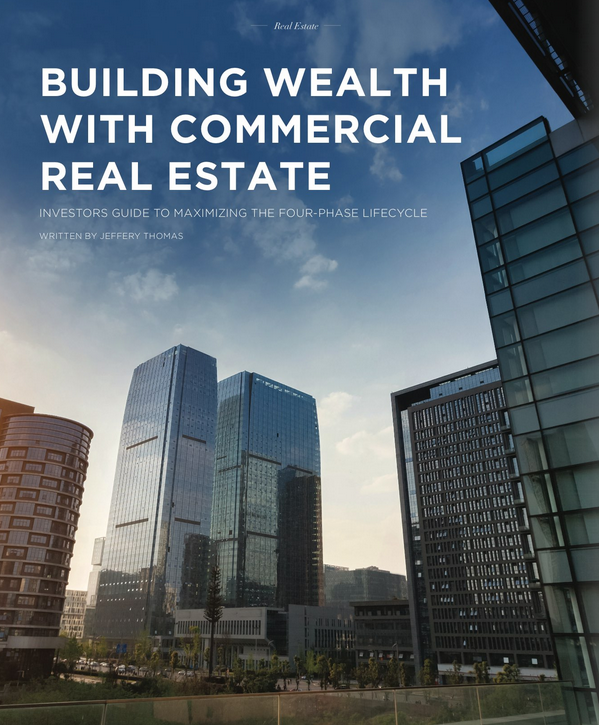Building Wealth With Commercial Real Estate
My feature in L.A. Dreams luxury lifestyle magazine. An investor’s guide to maximizing the four phase life cycle.
Investing in commercial real estate has proven to be an ideal method for developing wealth. Commercial real estate requires much more due diligence on the part of the investor who will not find a ready source of objective research like they do with stock market investments. For those willing to put in the work, the rewards may well be greater than what the stock market offers.
Real estate provides asset allocation for your overall investment portfolio since its market behavior is not correlated to stocks and bonds. According to Modern Portfolio Theory this non-correlation will reduce the volatility in an investment portfolio.
If you are looking to acquire commercial real estate or perhaps you already have, it is important to understand the four phases of the life cycle; acquire, develop, manage and exit.

Acquiring CRE
Before investing a penny into real estate it is important that you’ve given thought to your exit strategy. Since the idea is to profit from the venture, it is important to develop your idea of what that profit is. First, you should know where similar properties are valued. Then develop your plan to reach that target.
It’s really all about the deal. Your due diligence is your most reliable resource. When working with real estate agents, keep in the front of your mind that they are trying to sell the property more than they are trying to help you build wealth. If you exhaust your due diligence and still have doubts, walk away.
The CAP rate or a property’s capitalization rate is used for comparison purposes of similar properties in a given market. It is the ROA, return on asset, of the property. The current CAP rate of office buildings in Los Angeles according to CBRE is 5.50%. This number is arrived at by dividing the property’s net operating income by its current market value. A higher CAP rate offers a greater reward and of course, greater risk. When comparing properties it is important to listen to what the market tells you. If you have not yet acquired property the seller should be willing to provide you with a trailing 12 month income statement so you can run this calculation.
Whether you have fellow investors and your legal structure are your next considerations. You may go solo or with a group of investors which would be called a syndicate. Or a partnership may fit your situation where there are active and silent partners. A limited liability company and limited partnership are the most common legal structures. When forming the structure be cautious of popular ideas like forming your LLC in a state with low or no taxes. California can claim that you’ve done so simply to avoid taxes if California is your resident state and the income is earned in California. Then you will have excess legal expenses. Check with your tax attorney.
There’s nothing wrong with purchasing the property with current cash but, at least entertain offers from banks and other lenders. In the bigger picture it may make sense. When financing, your lender may require that you put some of your own money into the project.
Categories of commercial real estate include multi-family residential, retail, office buildings, industrial and warehouses. Where you should operate depends on two factors, where you can find the best deal and where you feel comfortable. If you own properties in more than one category or are looking to expand to additional properties, I recommend that you pick one category. The experiences you have at one property can be leveraged for success at other properties in the same category.
Office space is categorized into four classes; AA, A, B and C. Each class serves its different tenants. Class AA attracts top law firms, brokerage firms and similar tenants while Class C is filled with startups on a tight budget, solo practitioner insurance agents and other similar service businesses. Each group has its own risk/reward ratio. It’s all about the deal that you can make.
Retail space is often leased under a triple net lease. The tenant is responsible for property taxes, insurance and maintenance. Such leases carry lower rent since the property owner is freed from these expenses and the retail tenant has greater control over the properties appearance.
Develop Up The Property
This phase of the cycle has one goal, increase NOI, net operating income. NOI is gross operating income minus the property’s regular operating expenses. This does not include any mortgage or property taxes. Increasing NOI is as simple as cutting expenses and increasing revenue. It is increase in NOI that will determine the future value of the property when it comes time to sell.
Cutting expenses requires a constant evaluation of current expenses. For an office building that’s everything from restroom paper products to service providers and vendors. I’m not saying cut your services to the bare bones at the expense of quality for the sake of reducing costs. But find better value when you can. The most important service that cannot be skimped on is janitorial. Every office building that I’ve turned around started with my approach to janitorial; no one notices cleanliness, but everyone notices the lack of it. Even here, though, put your contract out on competitive bid.
Increasing top line revenue starts with understanding where you are currently in the marketplace. Study your peer group. Research can often be done via websites like loopnet.com to get an understanding of where your property fits on price per square foot. Then develop your plan to rise above your current price incrementally until you’ve maxed out the marketplace. Your property may need a sizable investment or may only need simple changes. An office building in Las Vegas that I consulted on made noticeable advancements with simple things like changing plants and upgrading furniture in the lobby and elsewhere, bringing in friendly staff and staging vacant offices so that they are more visually appealing. Potential tenants cannot always visualize what the space could look like. Staging helps.
Regardless of your plan, keep your DCR (debt coverage ratio) at 125% or better if you financed the purchase. If your mortgage payment is $100,000 annually for example, then you need to keep your NOI at $125,000 or above.
From time to time, government entities may offer tax credits for historical restoration of older buildings especially in business zones that have become the target of gentrification. Grant money may come available as well. Should you participate, ascertain what the grantor wants to read in the application that you submit to improve the odds of being awarded.
Managing Your Property
The most important consideration in managing your property is the money value of your time. It’s easy to get bogged down in time consuming projects at the expense of your regular career and your personal life. Bringing in a property manager is your solution. You need a system in place to hold your property manager accountable. A monthly meeting to recap the past month and prepare for the upcoming month is the minimum. They should work with your accountant so that you have regular cash flow and P/L statements.
Determine if a turnkey manager fits your needs. Your cost will be higher but everything is managed through one point of contact. If you or someone in your syndicate have available time to manage certain aspects of the property then a part-time manager may be all you need.
All tenant agreements and addendums must be in writing. It is best to have all significant communications in writing. Even if just email, you have a written record. I’ve sent follow up emails after an in person conversation for this reason.
Remember, it costs less to keep a tenant than to acquire a new tenant. Little things like Thank You cards sent to tenants at Thanksgiving and Welcome Packages to new tenants make a difference. So do big things like excellent WiFi throughout the building, conference rooms available on a per use basis and a snack bar or lounge. These things help you beat your competition.
Time To Exit
Success! You’ve developed up your property, managed it successfully and increased NOI by a sizable amount. And you determine that you have increased NOI to its max. You’ve now increased the expected market value by a corresponding amount. Time to sell.
Here are a few words of caution as you enter this phase of the cycle. Do not get emotionally attached to a property. Mistakes happen when your emotions make your decisions. It’s a numbers business and numbers are what matters. However, don’t sell until you have a target to redeploy the proceeds. You will have 180 days after the closing to defer capital gains taxes or loss by executing a 1031 Exchange, so named after the IRS Code Section. The next property must be like-kind property. The Code Section reads:
“Properties are of like-kind if they’re of the same nature or character, even if they differ in grade or quality.
Real properties generally are of like-kind, regardless of whether they’re improved or unimproved. For example, an apartment building would generally be like-kind to another apartment building. However, real property in the United States is not like-kind to real property outside the United States.”
This is where a real estate attorney shows their value. I find it better to pay for the guidance than to unexpectedly have to pay capital gains taxes because a mistake was made on the exchange.
Historically, commercial real estate has been a source of wealth development. With the proper approach it could be for you, too.
###


